airbag JEEP RENEGADE 2018 Owner handbook (in English)
[x] Cancel search | Manufacturer: JEEP, Model Year: 2018, Model line: RENEGADE, Model: JEEP RENEGADE 2018Pages: 356, PDF Size: 6.11 MB
Page 71 of 356
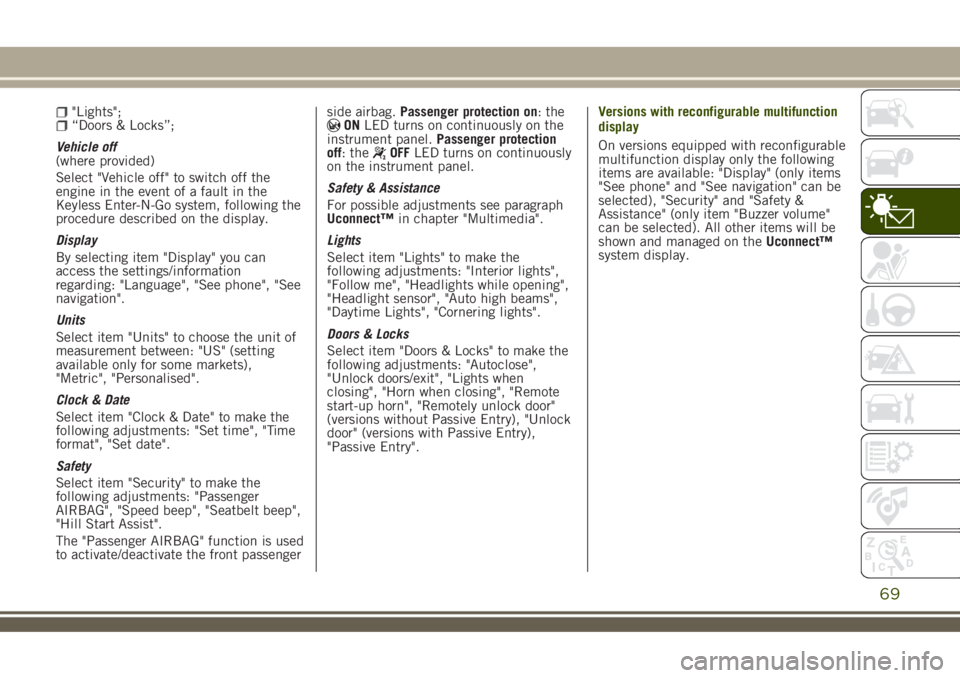
"Lights";“Doors & Locks”;
Vehicle off
(where provided)
Select "Vehicle off" to switch off the
engine in the event of a fault in the
Keyless Enter-N-Go system, following the
procedure described on the display.
Display
By selecting item "Display" you can
access the settings/information
regarding: "Language", "See phone", "See
navigation".
Units
Select item "Units" to choose the unit of
measurement between: "US" (setting
available only for some markets),
"Metric", "Personalised".
Clock & Date
Select item "Clock & Date" to make the
following adjustments: "Set time", "Time
format", "Set date".
Safety
Select item "Security" to make the
following adjustments: "Passenger
AIRBAG", "Speed beep", "Seatbelt beep",
"Hill Start Assist".
The "Passenger AIRBAG" function is used
to activate/deactivate the front passengerside airbag.Passenger protection on: theONLED turns on continuously on the
instrument panel.Passenger protection
off: the
OFFLED turns on continuously
on the instrument panel.
Safety & Assistance
For possible adjustments see paragraph
Uconnect™in chapter "Multimedia".
Lights
Select item "Lights" to make the
following adjustments: "Interior lights",
"Follow me", "Headlights while opening",
"Headlight sensor", "Auto high beams",
"Daytime Lights", "Cornering lights".
Doors & Locks
Select item "Doors & Locks" to make the
following adjustments: "Autoclose",
"Unlock doors/exit", "Lights when
closing", "Horn when closing", "Remote
start-up horn", "Remotely unlock door"
(versions without Passive Entry), "Unlock
door" (versions with Passive Entry),
"Passive Entry".Versions with reconfigurable multifunction
display
On versions equipped with reconfigurable
multifunction display only the following
items are available: "Display" (only items
"See phone" and "See navigation" can be
selected), "Security" and "Safety &
Assistance" (only item "Buzzer volume"
can be selected). All other items will be
shown and managed on theUconnect™
system display.
69
Page 75 of 356
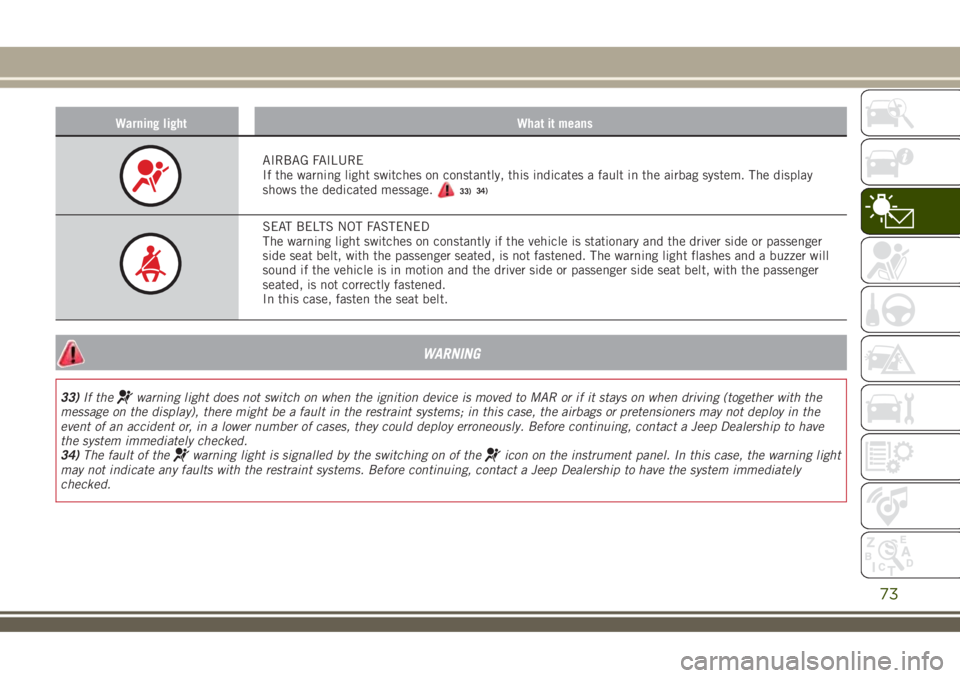
Warning light What it means
AIRBAG FAILURE
If the warning light switches on constantly, this indicates a fault in the airbag system. The display
shows the dedicated message.
33)
SEAT BELTS NOT FASTENED
The warning light switches on constantly if the vehicle is stationary and the driver side or passenger
side seat belt, with the passenger seated, is not fastened. The warning light flashes and a buzzer will
sound if the vehicle is in motion and the driver side or passenger side seat belt, with the passenger
seated, is not correctly fastened.
In this case, fasten the seat belt.
WARNING
33)If thewarning light does not switch on when the ignition device is moved to MAR or if it stays on when driving (together with the
message on the display), there might be a fault in the restraint systems; in this case, the airbags or pretensioners may not deploy in the
event of an accident or, in a lower number of cases, they could deploy erroneously. Before continuing, contact a Jeep Dealership to have
the system immediately checked.
34)The fault of the
warning light is signalled by the switching on of theicon on the instrument panel. In this case, the warning light
may not indicate any faults with the restraint systems. Before continuing, contact a Jeep Dealership to have the system immediately
checked.
73
34)
Page 85 of 356
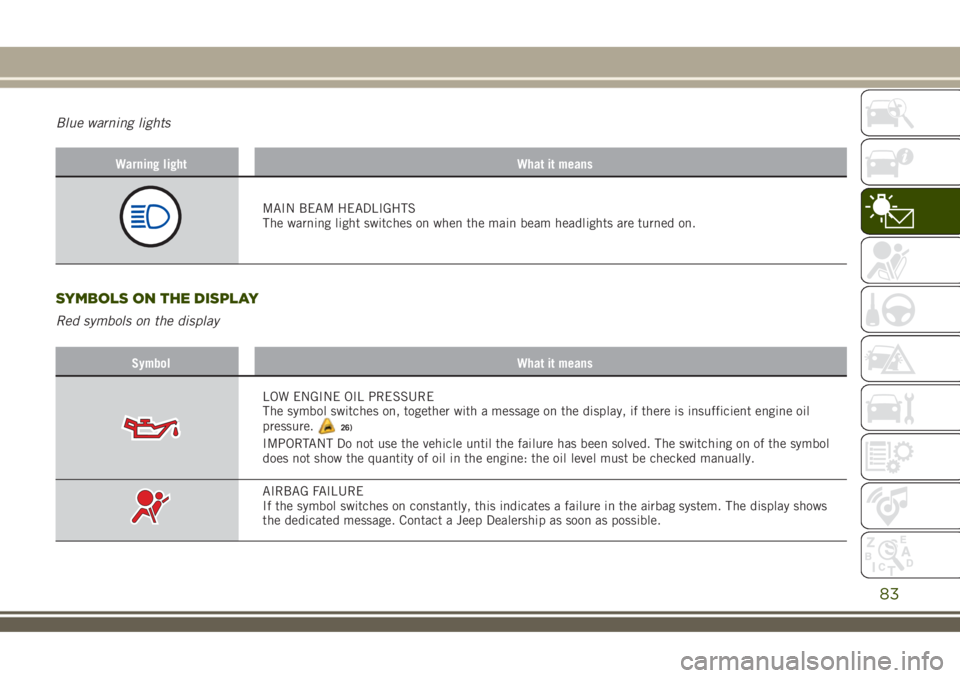
Blue warning lights
Warning light What it means
MAIN BEAM HEADLIGHTS
The warning light switches on when the main beam headlights are turned on.
SYMBOLS ON THE DISPLAY
Red symbols on the display
Symbol What it means
LOW ENGINE OIL PRESSURE
The symbol switches on, together with a message on the display, if there is insufficient engine oil
pressure.
26)
IMPORTANT Do not use the vehicle until the failure has been solved. The switching on of the symbol
does not show the quantity of oil in the engine: the oil level must be checked manually.
AIRBAG FAILURE
If the symbol switches on constantly, this indicates a failure in the airbag system. The display shows
the dedicated message. Contact a Jeep Dealership as soon as possible.
83
Page 103 of 356
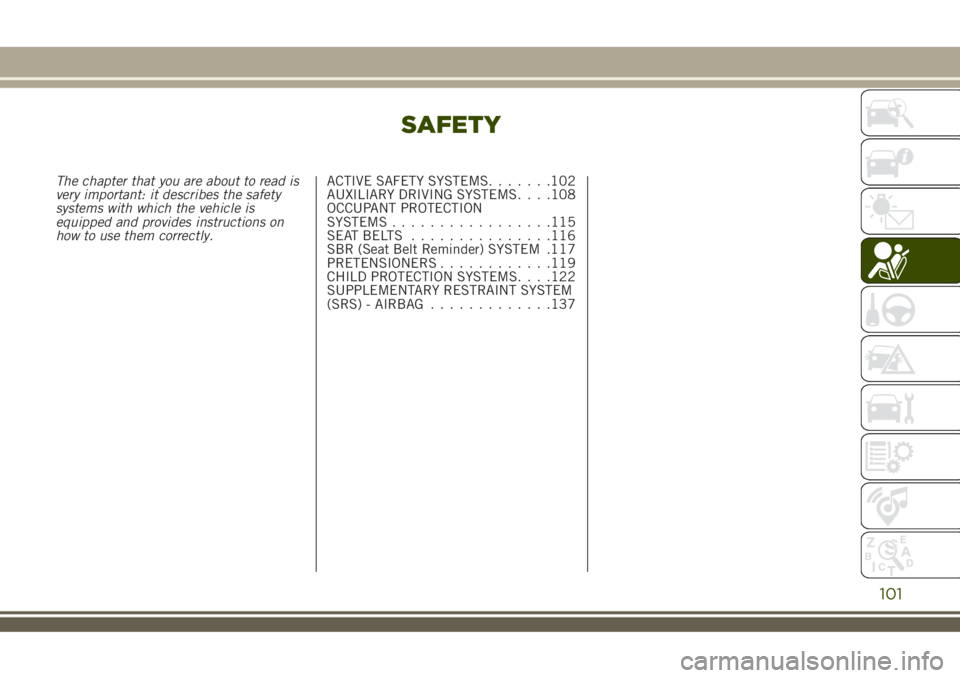
SAFETY
The chapter that you are about to read is
very important: it describes the safety
systems with which the vehicle is
equipped and provides instructions on
how to use them correctly.ACTIVE SAFETY SYSTEMS.......102
AUXILIARY DRIVING SYSTEMS. . . .108
OCCUPANT PROTECTION
SYSTEMS.................115
SEATBELTS ...............116
SBR (Seat Belt Reminder) SYSTEM .117
PRETENSIONERS............119
CHILD PROTECTION SYSTEMS. . . .122
SUPPLEMENTARY RESTRAINT SYSTEM
(SRS) - AIRBAG.............137
101
Page 117 of 356
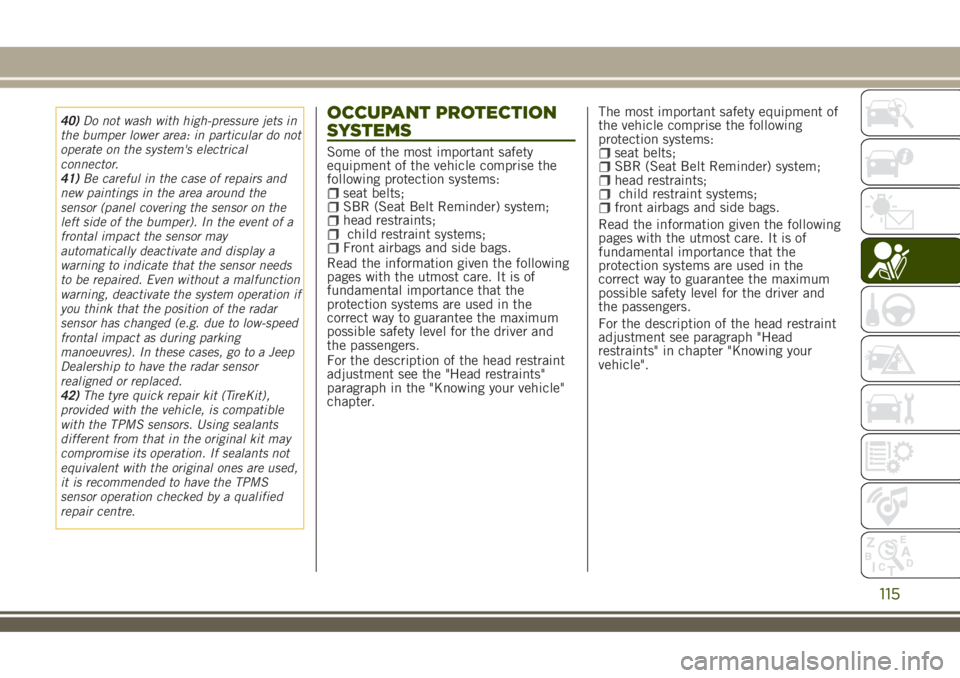
40)Do not wash with high-pressure jets in
the bumper lower area: in particular do not
operate on the system's electrical
connector.
41)Be careful in the case of repairs and
new paintings in the area around the
sensor (panel covering the sensor on the
left side of the bumper). In the event of a
frontal impact the sensor may
automatically deactivate and display a
warning to indicate that the sensor needs
to be repaired. Even without a malfunction
warning, deactivate the system operation if
you think that the position of the radar
sensor has changed (e.g. due to low-speed
frontal impact as during parking
manoeuvres). In these cases, go to a Jeep
Dealership to have the radar sensor
realigned or replaced.
42)The tyre quick repair kit (TireKit),
provided with the vehicle, is compatible
with the TPMS sensors. Using sealants
different from that in the original kit may
compromise its operation. If sealants not
equivalent with the original ones are used,
it is recommended to have the TPMS
sensor operation checked by a qualified
repair centre.OCCUPANT PROTECTION
SYSTEMS
Some of the most important safety
equipment of the vehicle comprise the
following protection systems:
seat belts;SBR (Seat Belt Reminder) system;head restraints;child restraint systems;Front airbags and side bags.
Read the information given the following
pages with the utmost care. It is of
fundamental importance that the
protection systems are used in the
correct way to guarantee the maximum
possible safety level for the driver and
the passengers.
For the description of the head restraint
adjustment see the "Head restraints"
paragraph in the "Knowing your vehicle"
chapter.The most important safety equipment of
the vehicle comprise the following
protection systems:
seat belts;SBR (Seat Belt Reminder) system;head restraints;child restraint systems;front airbags and side bags.
Read the information given the following
pages with the utmost care. It is of
fundamental importance that the
protection systems are used in the
correct way to guarantee the maximum
possible safety level for the driver and
the passengers.
For the description of the head restraint
adjustment see paragraph "Head
restraints" in chapter "Knowing your
vehicle".
115
Page 138 of 356
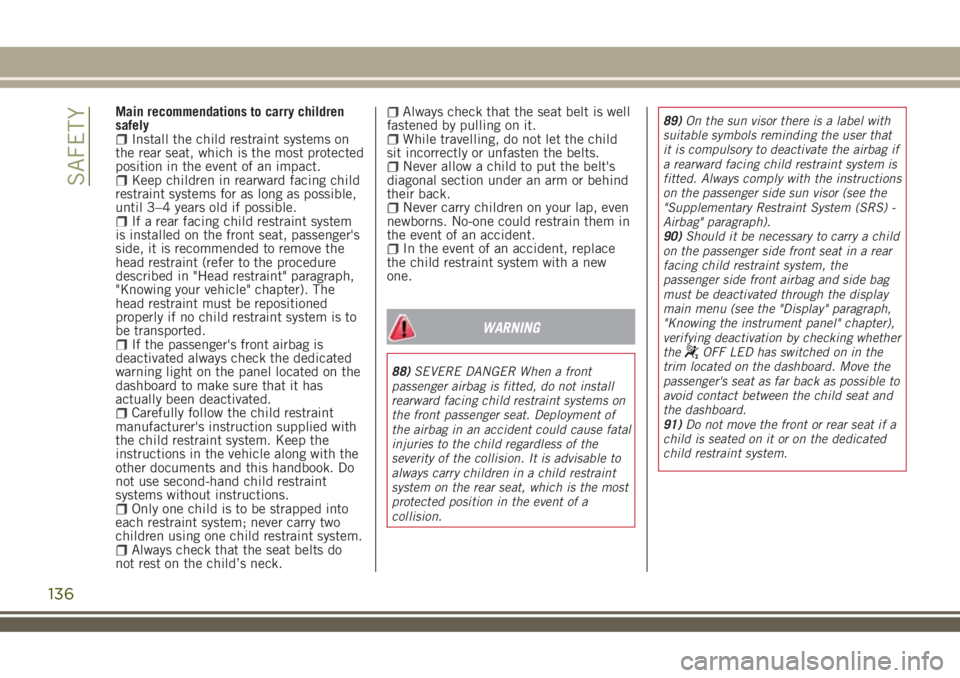
Main recommendations to carry children
safely
Install the child restraint systems on
the rear seat, which is the most protected
position in the event of an impact.
Keep children in rearward facing child
restraint systems for as long as possible,
until 3–4 years old if possible.
If a rear facing child restraint system
is installed on the front seat, passenger's
side, it is recommended to remove the
head restraint (refer to the procedure
described in "Head restraint" paragraph,
"Knowing your vehicle" chapter). The
head restraint must be repositioned
properly if no child restraint system is to
be transported.
If the passenger's front airbag is
deactivated always check the dedicated
warning light on the panel located on the
dashboard to make sure that it has
actually been deactivated.
Carefully follow the child restraint
manufacturer's instruction supplied with
the child restraint system. Keep the
instructions in the vehicle along with the
other documents and this handbook. Do
not use second-hand child restraint
systems without instructions.
Only one child is to be strapped into
each restraint system; never carry two
children using one child restraint system.
Always check that the seat belts do
not rest on the child’s neck.
Always check that the seat belt is well
fastened by pulling on it.
While travelling, do not let the child
sit incorrectly or unfasten the belts.
Never allow a child to put the belt's
diagonal section under an arm or behind
their back.
Never carry children on your lap, even
newborns. No-one could restrain them in
the event of an accident.
In the event of an accident, replace
the child restraint system with a new
one.
WARNING
88)SEVERE DANGER When a front
passenger airbag is fitted, do not install
rearward facing child restraint systems on
the front passenger seat. Deployment of
the airbag in an accident could cause fatal
injuries to the child regardless of the
severity of the collision. It is advisable to
always carry children in a child restraint
system on the rear seat, which is the most
protected position in the event of a
collision.89)On the sun visor there is a label with
suitable symbols reminding the user that
it is compulsory to deactivate the airbag if
a rearward facing child restraint system is
fitted. Always comply with the instructions
on the passenger side sun visor (see the
"Supplementary Restraint System (SRS) -
Airbag" paragraph).
90)Should it be necessary to carry a child
on the passenger side front seat in a rear
facing child restraint system, the
passenger side front airbag and side bag
must be deactivated through the display
main menu (see the "Display" paragraph,
"Knowing the instrument panel" chapter),
verifying deactivation by checking whether
the
OFF LED has switched on in the
trim located on the dashboard. Move the
passenger's seat as far back as possible to
avoid contact between the child seat and
the dashboard.
91)Do not move the front or rear seat if a
child is seated on it or on the dedicated
child restraint system.
136
SAFETY
Page 139 of 356
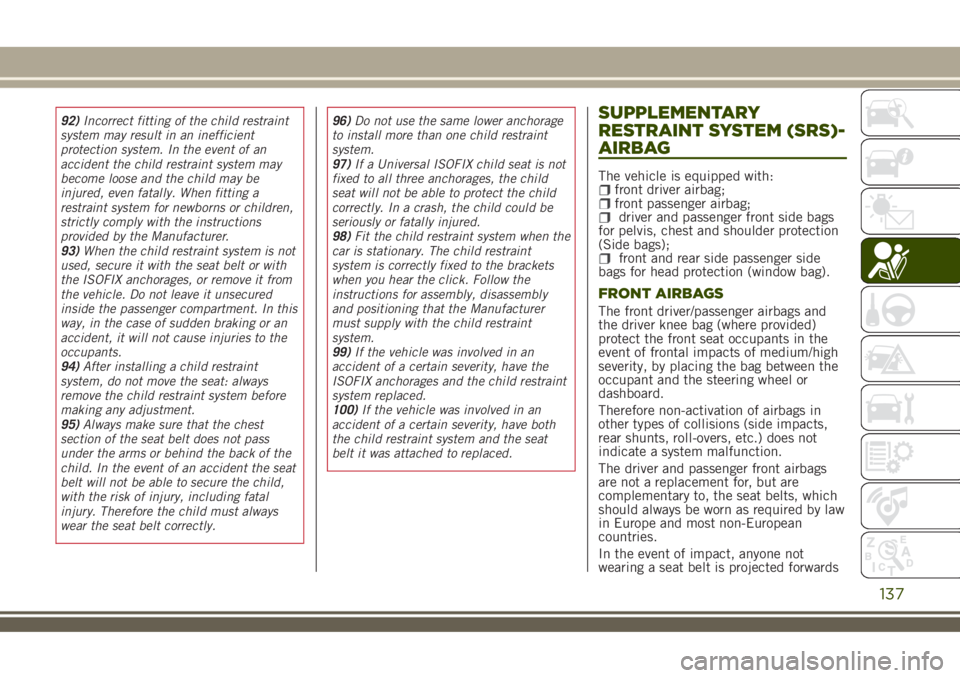
92)Incorrect fitting of the child restraint
system may result in an inefficient
protection system. In the event of an
accident the child restraint system may
become loose and the child may be
injured, even fatally. When fitting a
restraint system for newborns or children,
strictly comply with the instructions
provided by the Manufacturer.
93)When the child restraint system is not
used, secure it with the seat belt or with
the ISOFIX anchorages, or remove it from
the vehicle. Do not leave it unsecured
inside the passenger compartment. In this
way, in the case of sudden braking or an
accident, it will not cause injuries to the
occupants.
94)After installing a child restraint
system, do not move the seat: always
remove the child restraint system before
making any adjustment.
95)Always make sure that the chest
section of the seat belt does not pass
under the arms or behind the back of the
child. In the event of an accident the seat
belt will not be able to secure the child,
with the risk of injury, including fatal
injury. Therefore the child must always
wear the seat belt correctly.96)Do not use the same lower anchorage
to install more than one child restraint
system.
97)If a Universal ISOFIX child seat is not
fixed to all three anchorages, the child
seat will not be able to protect the child
correctly. In a crash, the child could be
seriously or fatally injured.
98)Fit the child restraint system when the
car is stationary. The child restraint
system is correctly fixed to the brackets
when you hear the click. Follow the
instructions for assembly, disassembly
and positioning that the Manufacturer
must supply with the child restraint
system.
99)If the vehicle was involved in an
accident of a certain severity, have the
ISOFIX anchorages and the child restraint
system replaced.
100)If the vehicle was involved in an
accident of a certain severity, have both
the child restraint system and the seat
belt it was attached to replaced.SUPPLEMENTARY
RESTRAINT SYSTEM (SRS)-
AIRBAG
The vehicle is equipped with:front driver airbag;front passenger airbag;driver and passenger front side bags
for pelvis, chest and shoulder protection
(Side bags);
front and rear side passenger side
bags for head protection (window bag).
FRONT AIRBAGS
The front driver/passenger airbags and
the driver knee bag (where provided)
protect the front seat occupants in the
event of frontal impacts of medium/high
severity, by placing the bag between the
occupant and the steering wheel or
dashboard.
Therefore non-activation of airbags in
other types of collisions (side impacts,
rear shunts, roll-overs, etc.) does not
indicate a system malfunction.
The driver and passenger front airbags
are not a replacement for, but are
complementary to, the seat belts, which
should always be worn as required by law
in Europe and most non-European
countries.
In the event of impact, anyone not
wearing a seat belt is projected forwards
137
Page 140 of 356
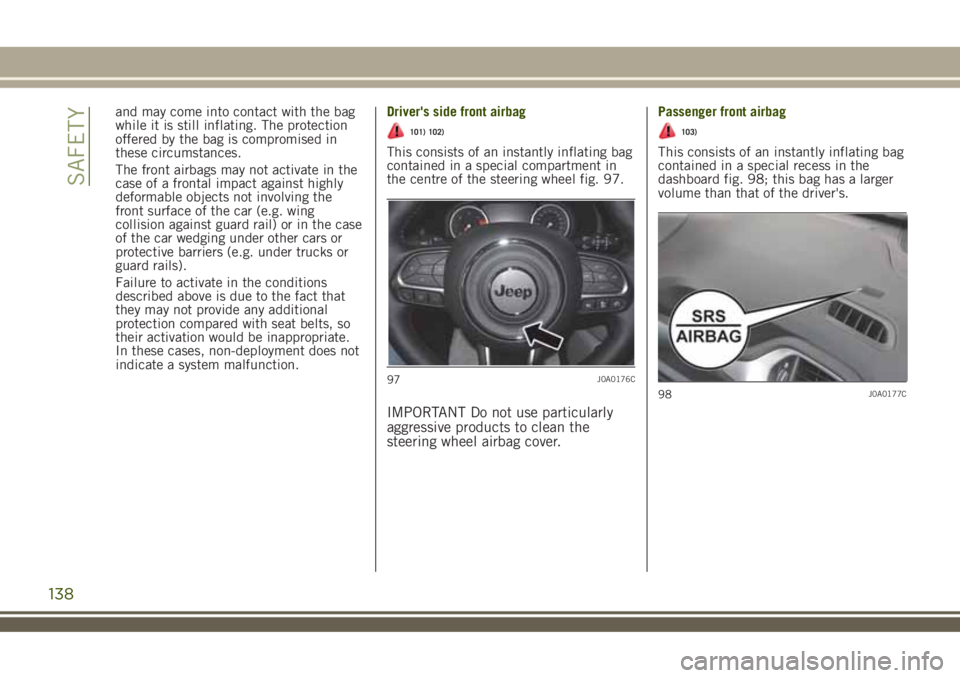
and may come into contact with the bag
while it is still inflating. The protection
offered by the bag is compromised in
these circumstances.
The front airbags may not activate in the
case of a frontal impact against highly
deformable objects not involving the
front surface of the car (e.g. wing
collision against guard rail) or in the case
of the car wedging under other cars or
protective barriers (e.g. under trucks or
guard rails).
Failure to activate in the conditions
described above is due to the fact that
they may not provide any additional
protection compared with seat belts, so
their activation would be inappropriate.
In these cases, non-deployment does not
indicate a system malfunction.Driver's side front airbag
101) 102)
This consists of an instantly inflating bag
contained in a special compartment in
the centre of the steering wheel fig. 97.
IMPORTANT Do not use particularly
aggressive products to clean the
steering wheel airbag cover.
Passenger front airbag
103)
This consists of an instantly inflating bag
contained in a special recess in the
dashboard fig. 98; this bag has a larger
volume than that of the driver's.
97J0A0176C
98J0A0177C
138
SAFETY
Page 141 of 356

Passenger's front airbag and child restraint
systems
Rearward facing child restraint systems
mustNEVERbe fitted on the front seat
with an active passenger side airbag
since in the event of an impact the
airbag activation may cause fatal injuries
to the transported child.ALWAYScomply
with the instructions on the label stuck
on the passenger side sun visor fig. 99.Deactivating the passenger side airbags:
front airbag and side bag
If a child must be carried on the front
seat in a rear-facing child restraint
system, deactivate the passenger side
front airbag and front side bag. Use the
display Menu to deactivate them.
There are
OFFandONLEDs on the
dashboard trim. Moving the ignition
device to MAR, the two LEDs switch on
for a few seconds. Otherwise, contact a
Jeep Dealership.
During the first seconds, the activation of
the LEDs does not actually show the
passenger protection status, but only
checks its correct operation. After a test
of a few seconds, the LEDs will indicate
the status of the passenger airbag
protection.Passenger protection activated: the
ON
fig. 100 LED switches on fixed.
Passenger protection deactivated: the
OFFfig. 100 LED switches on with a
steady light.
The LEDs may light up with various
intensity levels depending on the vehicle
conditions. The intensity may vary during
the same key cycle.
99J0A0190C
100J0A0922C
139
Page 142 of 356
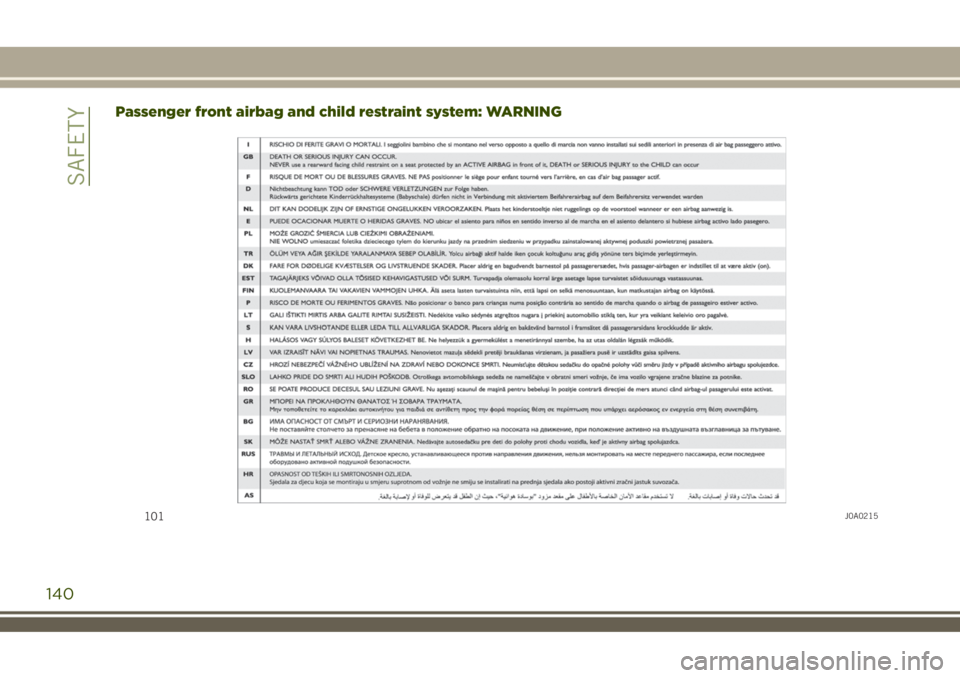
Passenger front airbag and child restraint system: WARNING
101J0A0215
140
SAFETY